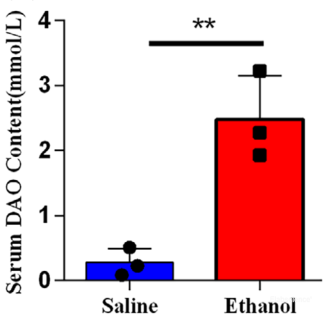Diamine Oxidase (DAO) Activity Assay Kit
SKU: E-BC-K524-M-96
Diamine Oxidase (DAO) Activity Assay Kit
| SKU # | E-BC-K524-M |
| Detection Instrument | Microplate reader (450-470 nm, optimum wavelength: 460 nm) |
| Detection method | Colorimetric method |
Product Details
Properties
| Synonyms | DAO |
| Sample type | Serum, plasma, urine, animal tissue and cell samples |
| Sensitivity | 7.39 U/L |
| Detection range | 7.39-134.15 U/L |
| Detection Method | Colorimetric method |
| Assay type | Enzyme Activity |
| Assay time | 60 min |
| Precision | Average inter-assay CV: 7% | Average intra-assay CV: 5% |
| Other instruments required | Centrifuge, Incubator, Microplate reader |
| Storage | 2-8℃ |
| Valid period | 12 months |
Images
L Zhao et al investigate the osteoporosis and altered gut microbiota induced by ethanol. Diamine oxidase (DAO) activity of rat serum was determined using DAO activity assay kit (E-BC-K524-M).

Activity of DAO was significantly induced by ethanol. (**P<0.01)
Dilution of Sample
The recommended dilution factor for different samples is as follows (for reference only):
| Sample type | Dilution factor |
| Human serum | 2-4 |
| Human plasma | 1 |
| Rat serum | 1 |
| Rat plasma | 1 |
| Mouse serum | 1 |
| Mouse plasma | 1 |
| 10% Rat liver tissue homogenate | 1 |
| 10% Rat kidney tissue homogenate | 1 |
| 10% Rat heart tissue homogenate | 1 |
| Human urine | 1 |
| Hela Cells (1×106) | 1 |
Note: The diluent is buffer solution. For the dilution of other sample types, please do pretest to confirm the dilution factor
Detection Principle
Diamine oxidase can catalyse amine substances to produce hydrogen peroxide, and hydrogen peroxide can react with the chromogenic substance to produce chromogenic substance, which has a characteristic absorption peak at 460 nm. The activity of diamine oxidase can be calculated by measuring the change rate of absorbance per unit time.
Kit Components & Storage
| Item | Component | Size (96 T) | Storage |
| Reagent 1 | Buffer Solution | 60 mL × 1 vial | 2-8℃, 12 months |
| Reagent 2 | Substrate | 1.5 mL × 2 vials | 2-8℃, 12 months shading light |
| Reagent 3 | Enzyme Reagent | Powder × 1 vial | 2-8℃, 12 months shading light |
| Reagent 4 | Chromogenic Agent | Powder × 1 vial | 2-8℃, 12 months shading light |
| Reagent 5 | Stop Agent | 10 mL × 1 vial | 2-8℃, 12 months |
| Reagent 6 | 100 mmol/L Standard | 1 mL × 1 vial | 2-8℃, 12 months shading light |
| Microplate | 96 wells | No requirement | |
| Plate Sealer | 2 pieces |
Note: The reagents must be stored strictly according to the preservation conditions in the above table. The reagents in different kits cannot be mixed with each other. For a small volume of reagents, please centrifuge before use, so as not to obtain sufficient amount of reagents.
Technical Data:
Parameter:
Intra-assay Precision
Three human serum samples were assayed in replicates of 20 to determine precision within an assay. (CV = Coefficient of Variation)
| Parameters | Sample 1 | Sample 2 | Sample 3 |
| Mean (U/L) | 18.4 | 62.5 | 112.0 |
| %CV | 5.6 | 5.2 | 4.2 |
Inter-assay Precision
Three human serum samples were assayed 17 times in duplicate by three operators to determine precision between assays.
| Parameters | Sample 1 | Sample 2 | Sample 3 |
| Mean (U/L) | 18.4 | 62.5 | 112.0 |
| %CV | 6.4 | 7.2 | 7.4 |
Recovery
Take three samples of high concentration, middle concentration and low concentration to test the samples of each concentration for 6 times parallelly to get the average recovery rate of 105%.
| Standard 1 | Standard 2 | Standard 3 | |
| Expected Conc. (mmol/L) | 0.35 | 0.94 | 1.3 |
| Observed Conc. (mmol/L) | 0.4 | 1.0 | 1.4 |
| Recovery rate (%) | 101 | 106 | 108 |
Sensitivity
The analytical sensitivity of the assay is 7.39 U/L. This was determined by adding two standard deviations to the mean O.D. obtained when the zero standard was assayed 20 times, and calculating the corresponding concentration.
Standard Curve
As the OD value of the standard curve may vary according to the conditions of the actual assay performance (e.g. operator, pipetting technique or temperature effects), so the standard curve and data are provided as below for reference only:
| Concentration (mmol/L) | 0 | 0.2 | 0.5 | 0.7 | 1.0 | 1.2 | 1.5 | 2.0 |
| OD value | 0.065 | 0.098 | 0.161 | 0.198 | 0.280 | 0.336 | 0.413 | 0.556 |
| 0.064 | 0.100 | 0.160 | 0.208 | 0.282 | 0.336 | 0.419 | 0.555 | |
| Average OD | 0.065 | 0.099 | 0.161 | 0.203 | 0.281 | 0.336 | 0.416 | 0.556 |
| Absoluted OD | 0.000 | 0.035 | 0.096 | 0.139 | 0.217 | 0.272 | 0.352 | 0.491 |



